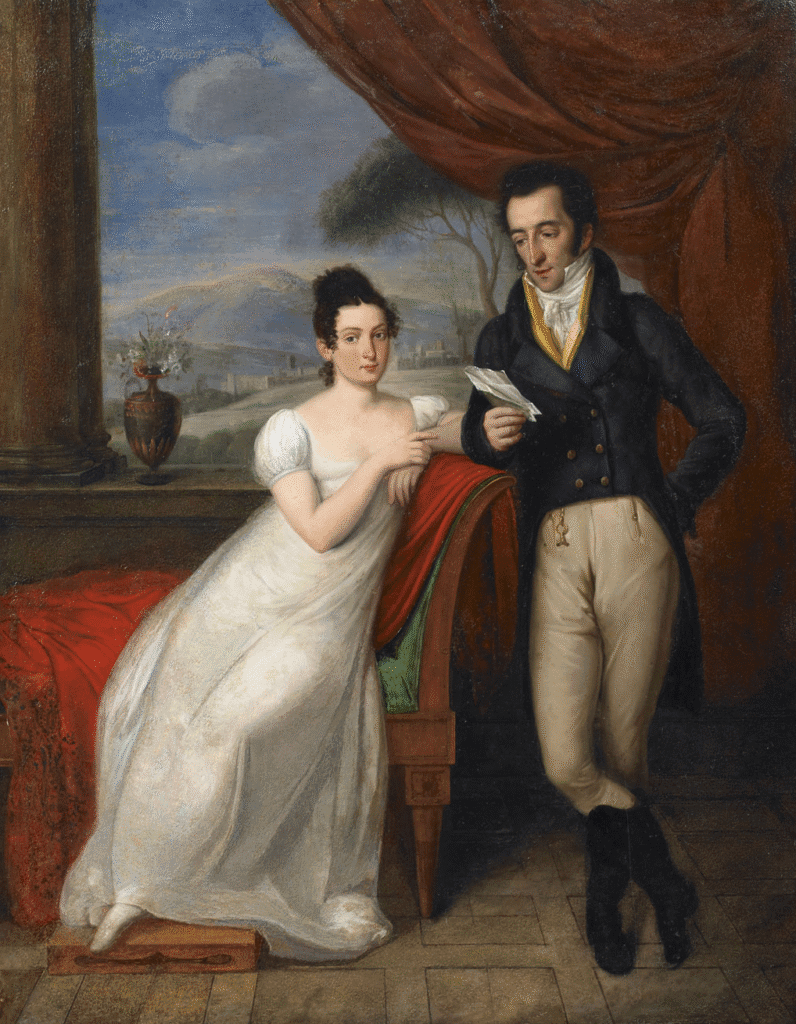The Price of Patriotism
Roman Women Offering Their Jewellery in Defence of the State – Vincenzo Camuccini, c. 1825–1829 – Neoclassicism
Painted in the final years of his career, Vincenzo Camuccini’s sweeping canvas captures a defining act of civic virtue. Created between 1825 and 1829, this neoclassical masterpiece draws from ancient Roman history to present a timeless question: What are we willing to give for the good of all?
In its solemn grandeur and dramatic balance, the painting is both a celebration of sacrifice and a quiet rebuke to complacency. It is history, yes—but it is also a mirror.
The Scene Before Us
Inside a classical Roman temple or public hall, a group of women approach a table of solemn officials. Their garments flow in soft folds, painted in the pale, luminous tones favored by neoclassical artists. The setting is defined by symmetry and order—marble floors, tall columns, and arches receding into depth.
Each woman arrives not empty-handed but with offerings: bracelets, earrings, necklaces—objects of personal beauty, now surrendered for the greater cause. They bring them not with fanfare, but with quiet dignity. There is no sorrow here—only resolve.
One mother gently guides her daughter forward. Another clutches a young girl, sheltering her while passing forward a treasure. The officials, cloaked in heavier tones of brown and red, lean forward to receive what is given. Their faces are firm but respectful.
In the background, shadows gather, and a shaft of light descends upon the women—visually sanctifying their selfless act.
The Deeper Meaning
This is not merely a historical reenactment. Camuccini paints a political statement in the form of classical allegory.
The story likely references an event during the early Roman Republic, when women donated their personal jewels to support the state in wartime. But for Camuccini—painting in the years after the Napoleonic upheavals and amid Italy’s own stirrings toward unity—it was also a reflection on civic virtue, gender, and moral strength.
The women, not the soldiers or senators, are the heroes of this moment. They offer what they have—not out of compulsion, but out of belief. Their femininity is not in opposition to patriotism; it embodies it.
This painting reminds the viewer that democracy, justice, and peace do not rest only on the shoulders of leaders, but in the hearts and choices of ordinary citizens—especially those whose sacrifices go unsung.
A Moment Caught in Time
The grandeur of marble and the weight of history make this painting feel eternal, yet it is rooted in a fleeting moment—a gesture of giving. What makes it powerful is its stillness. The women do not shout or plead. They simply step forward and give.
Camuccini’s neoclassicism is not cold or remote; it is full of restrained emotion, grounded in form and guided by clarity. In this work, he gives voice to the quiet strength of women, the enduring call of duty, and the human capacity to give without promise of return.
About Artist

Vincenzo Camuccini was born on February 22, 1771, in Rome, Italy, and died on September 2, 1844, also in Rome. He was part of a family involved in art dealing and restoration; his older brother Pietro was a painter and art restorer who helped launch Vincenzo’s career by introducing him to the studio of Domenico Corvi. Camuccini studied intensively the frescoes of Michelangelo and Raphael at the Vatican between 1787 and 1789 and developed a strong foundation in classical art and chiaroscuro. He also studied archaeology under Ennio Quirino Visconti, which influenced his deep knowledge of classical antiquity shown in his works.
Camuccini gained recognition by making copies of Renaissance masters, but his reputation solidified with original Neoclassical history paintings inspired by Roman and Greek themes. He held highly influential positions including director of the Vatican mosaic workshop from 1803, superintendent of the Vatican Picture Galleries, and president of the Accademia di San Luca in Rome. He was knighted and given the hereditary title of Baron by Pope Pius VII.
Camuccini was a central figure in Neoclassical art in Italy and influenced Roman artistic life throughout the early 19th century. His career spanned the turbulent Napoleonic era during which he received commissions from Napoleon and his court. Despite later criticism by Romantics, his legacy endures as a premier Neoclassical history painter.
Artistic Style
Camuccini’s style is marked by Neoclassical ideals of simplicity, grandeur, and moral uplift inspired by ancient Roman and Greek traditions. He combined rigorous study of classical antiquity with lessons from Renaissance masters, especially Raphael, whose influence permeated his art. His paintings are composed with clarity and a sculptural sense of relief, where figures are arranged along the picture plane with calm dignity rather than deep spatial complexity.
While history paintings dominate his oeuvre, he also painted religious subjects with a slightly more Baroque influence. In his later years, his style showed more dramatic, diagonal compositions and freer brushwork but retained classical restraint overall. His works emphasize heroic virtue, sacrifice, and patriotism in line with contemporary Neoclassical themes.
Notable Artworks
- Roman Women Offering Their Jewellery in Defence of the State (c. 1825–1829): This powerful painting shows symbolic Roman women donating their jewelry to support the defense of their city. It is imbued with patriotic fervor and classical dignity. The work is displayed at the Kelvingrove Art Gallery and Museum in Glasgow. The composition uses warm ochres and reds, emphasizing the emotional gravity and historical significance of the act.
- The Death of Julius Caesar (1798): A major early success, this history painting represents the assassination of Caesar with compositional rigor and emotional restraint. The work solidified Camuccini’s reputation for dramatic historical scenes rooted in classical ideals.
- Scipio’s Moderation (1808–1811): Depicting a virtue of Roman general Scipio Africanus, this painting epitomizes Camuccini’s commitment to moral themes from Roman history. It is held at the Kunsthistorisches Museum in Vienna, showcasing his detailed and composed style.
- Presentation in the Temple (1806): Part of a commission for the church of San Giovanni in Piacenza, this religious canvas represents Camuccini’s forays into religious themes with classical clarity and grace.
Additional recognized works include portraits of Italian and European nobility as well as frescoes for significant Roman palaces and churches.
Vincenzo Camuccini remains an essential figure in Italian Neoclassicism, admired for his scholarly approach, polished technique, and dignified depiction of historical and religious subjects. His artworks emphasize classical virtue and patriotic sacrifice, reflecting the cultural ideals of his age.



